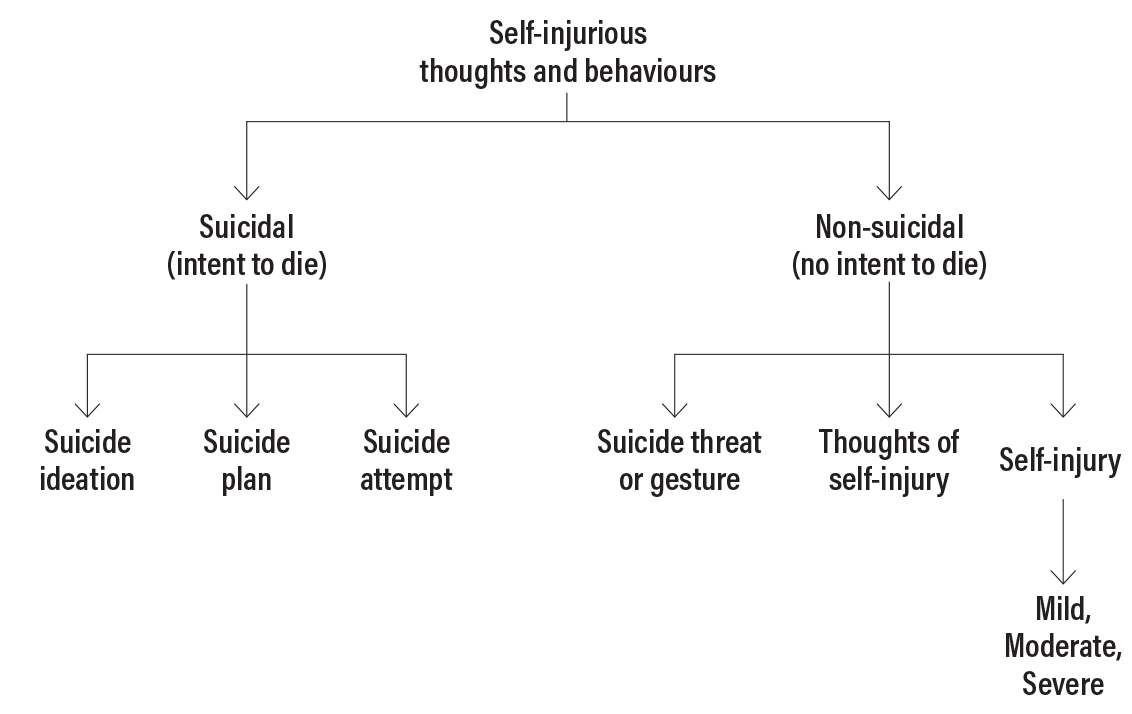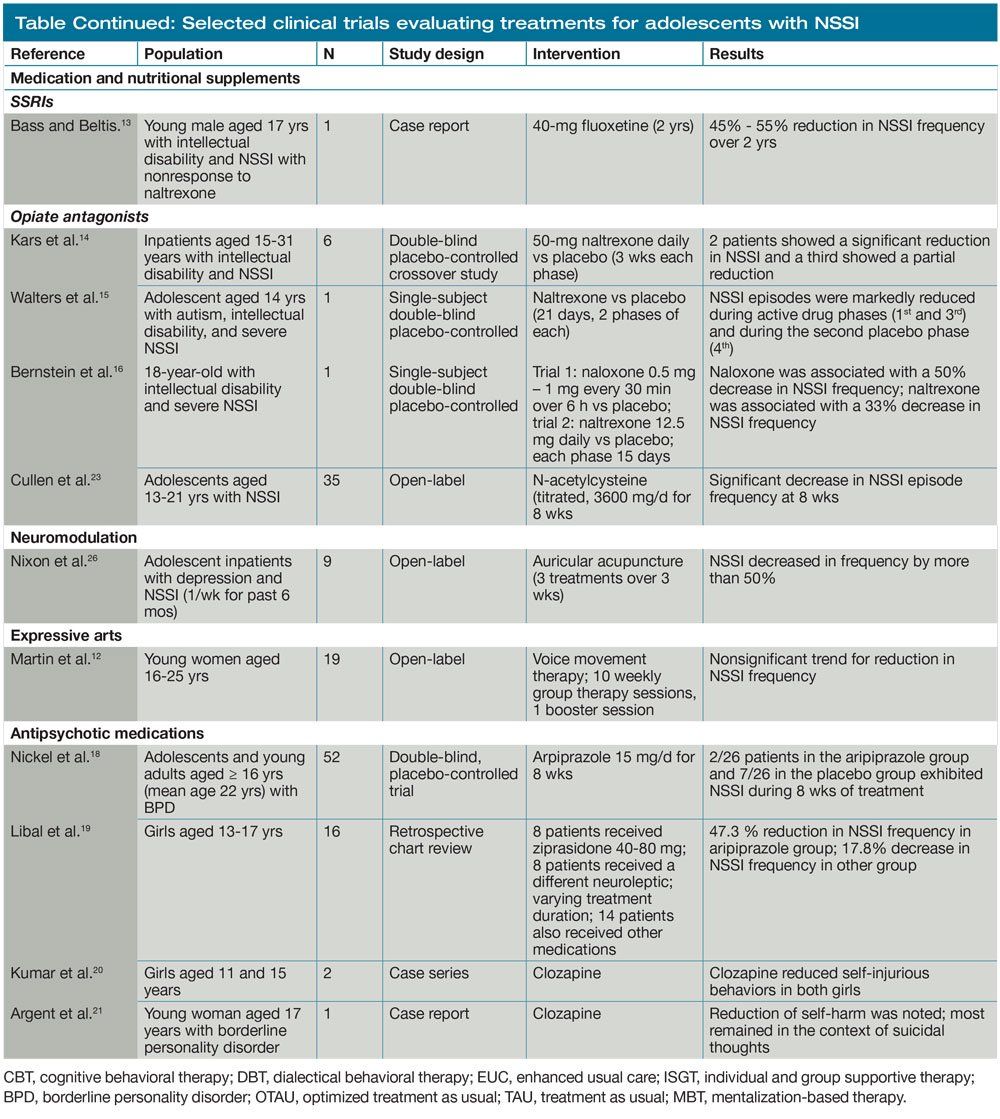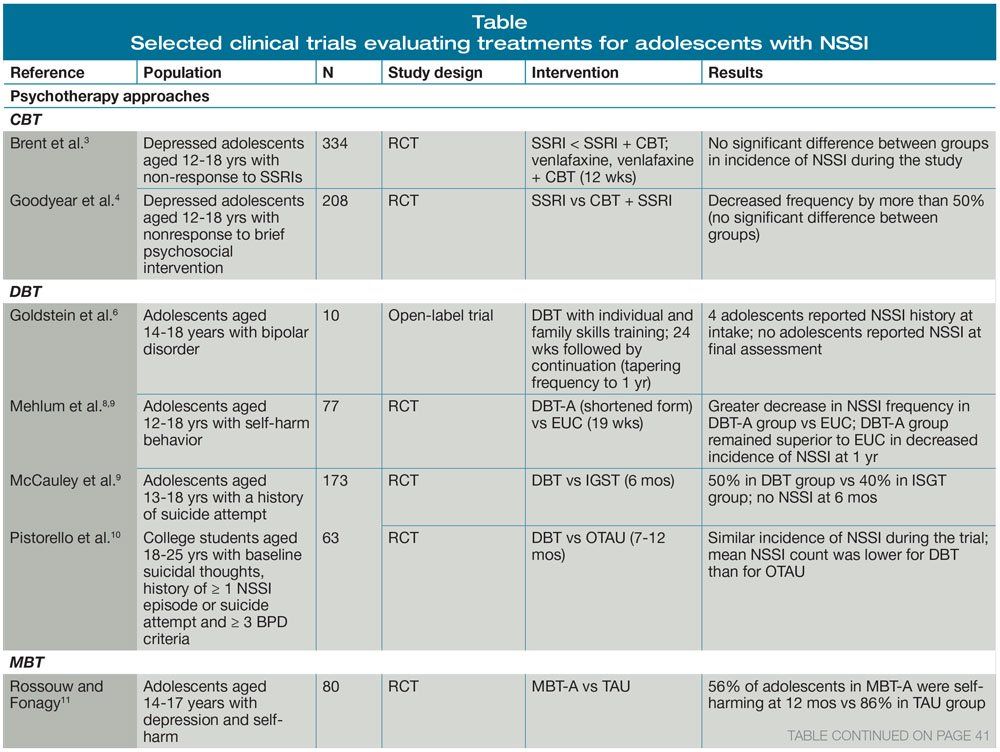Your Non suicidal self injury dsm 5 images are available in this site. Non suicidal self injury dsm 5 are a topic that is being searched for and liked by netizens today. You can Download the Non suicidal self injury dsm 5 files here. Find and Download all royalty-free vectors.
If you’re looking for non suicidal self injury dsm 5 pictures information connected with to the non suicidal self injury dsm 5 interest, you have pay a visit to the right blog. Our site frequently provides you with suggestions for refferencing the highest quality video and picture content, please kindly hunt and locate more informative video content and images that match your interests.
Non Suicidal Self Injury Dsm 5. Non-suicidal self-injury and DSM-5. Non-suicidal self-injury NSSI is a serious public health concern in adolescents. Plener PL Kapusta ND Kölch MG Kaess M Brunner R 2012 Non-suicidal self-injury as autonomous diagnosisimplications for research and clinic of the DSM-5 proposal to establish the diagnosis of non-suicidal self-injury in adolescents. Investigating the DSM-5 criteria for non-suicidal self-injury disorder in a community sample of adolescents.
 Dsm 5 Non Suicidal Self Injury Criteria In A Clinical Sample Of Self Harming Mexican Adolescents Revista Colombiana De Psiquiatria English Edition From elsevier.es
Dsm 5 Non Suicidal Self Injury Criteria In A Clinical Sample Of Self Harming Mexican Adolescents Revista Colombiana De Psiquiatria English Edition From elsevier.es
Non-Suicidal Self Injury in the DSM 5 As you likely already know a draft of the DSM 5 came out Wednesday. Theres a lot of interesting stuff to look through but the part I had the biggest reaction to was the addition of Non-Suicidal Self Injury. NSI disorder is currently classified in the DSM-5 as a condition. Non-suicidal self-injury and DSM-5. As we anxiously await the arrival of DSM-5 I am very excited about the inclusion of non-suicidal self-injury NSSI disorder. 6 In short when it comes to suicide risk NSSI presents double trouble in that it increases risk for both suicidal.
1 The study of suicide and self-injurious behaviour has.
The DSM5 nonsuicidal selfinjury disorder among incoming college students. Investigating the DSM-5 criteria for non-suicidal self-injury disorder in a community sample of adolescents. Since NSSID is a condition in need of further study. Non-suicidal self-injury and DSM-5. Prevalence and function of non-suicidal self-injury NSSI in a community sample of adolescents using suggested DSM-5 criteria for a potential NSSI disorder. The authors investigated the characteristics of NSSI disorder and the proposed diagnostic criteria.
Source:
Article Google Scholar 40. Non-Suicidal Self Injury in the DSM 5 As you likely already know a draft of the DSM 5 came out Wednesday. We at KISI were disappointed to find Non-Suicidal Self-Injury a diagnosis we fully expected to be part of DSM-5 relegated to the back of the book in a section on Conditions for Further Study It isnt available as a formal diagnosis. Viewed in this context NSSI may represent a unique risk factor for suicide as it is strongly associated with emotional and interpersonal distress 5 8 45 which increases risk for suicidal ideation and or desire and desensitizes people to the pain associated with SIBs which increases capability to act on suicidal desire. The entry for nonsuicidal self-injury NSI disorder in the 5th edition of the Diagnostic and Statistical Manual of Mental Disorders DSM-5 provides a criterion-based definition of clinically relevant NSI.
 Source: journals.rcni.com
Source: journals.rcni.com
Nonsuicidal self-injury NSSI is included as conditions for further study in the DSM-5. In 2013 DSM-5 recognized NSSI as a distinct clinical phenomenon and made a call for more systematic research by including Non-Suicidal Self-Injury-Disorder NSSI-D as a condition requiring further research. Z Kinder Jugendpsychiatr Psychoter 40113120. Viewed in this context NSSI may represent a unique risk factor for suicide as it is strongly associated with emotional and interpersonal distress 5 8 45 which increases risk for suicidal ideation and or desire and desensitizes people to the pain associated with SIBs which increases capability to act on suicidal desire. Plener PL Kapusta ND Kölch MG Kaess M Brunner R 2012 Non-suicidal self-injury as autonomous diagnosisimplications for research and clinic of the DSM-5 proposal to establish the diagnosis of non-suicidal self-injury in adolescents.
 Source: psychiatryadvisor.com
Source: psychiatryadvisor.com
Viewed in this context NSSI may represent a unique risk factor for suicide as it is strongly associated with emotional and interpersonal distress 5 8 45 which increases risk for suicidal ideation and or desire and desensitizes people to the pain associated with SIBs which increases capability to act on suicidal desire. Non-suicidal self-injury and DSM-5. Viewed in this context NSSI may represent a unique risk factor for suicide as it is strongly associated with emotional and interpersonal distress 5 8 45 which increases risk for suicidal ideation and or desire and desensitizes people to the pain associated with SIBs which increases capability to act on suicidal desire. In 2013 DSM-5 recognized NSSI as a distinct clinical phenomenon and made a call for more systematic research by including Non-Suicidal Self-Injury-Disorder NSSI-D as a condition requiring further research. With the presentation of nonsuicidal self-injury disorder NSSID criteria in the fifth version of the Statistical and Diagnostic Manual of Mental Disorders DSM-5 empirical studies have emerged where the criteria have been opera-tionalized on samples of children adolescents and young adults.
 Source: heartmindjournal.org
Source: heartmindjournal.org
NSSI was rejected for inclusion in DSM-IV possibly due to the fact that NSSI was seen as an integral part of Borderline Personality Disorder BPD. In 2013 DSM-5 recognized NSSI as a distinct clinical phenomenon and made a call for more systematic research by including Non-Suicidal Self-Injury-Disorder NSSI. Buelens T Luyckx K Kiekens G Gandhi A Muehlenkamp JJ Claes L. Z Kinder Jugendpsychiatr Psychoter 40113120. Funny that this is what interested me because in general research on self-injury bores me.
Source:
Article Google Scholar 40. Plener PL Kapusta ND Kölch MG Kaess M Brunner R 2012 Non-suicidal self-injury as autonomous diagnosisimplications for research and clinic of the DSM-5 proposal to establish the diagnosis of non-suicidal self-injury in adolescents. Z Kinder Jugendpsychiatr Psychoter 40113120. 1 The study of suicide and self-injurious behaviour has. Investigating the DSM-5 criteria for non-suicidal self-injury disorder in a community sample of adolescents.
 Source: researchgate.net
Source: researchgate.net
As we anxiously await the arrival of DSM-5 I am very excited about the inclusion of non-suicidal self-injury NSSI disorder. NSI disorder is currently classified in the DSM-5 as a condition. Article Google Scholar 40. Assessing DSM-5 nonsuicidal self-injury disorder in a clinical sample. Viewed in this context NSSI may represent a unique risk factor for suicide as it is strongly associated with emotional and interpersonal distress 5 8 45 which increases risk for suicidal ideation and or desire and desensitizes people to the pain associated with SIBs which increases capability to act on suicidal desire.
 Source: semanticscholar.org
Source: semanticscholar.org
Non-Suicidal Self-Injury Disorder Not Otherwise Specified NOS Type 1 Subthreshold. NSI disorder is currently classified in the DSM-5 as a condition. Z Kinder Jugendpsychiatr Psychoter 40113120. Non-suicidal self-injury NSSI is a serious public health concern in adolescents. Funny that this is what interested me because in general research on self-injury bores me.
 Source: researchgate.net
Source: researchgate.net
Non-suicidal self-injury NSSI is a serious public health concern in adolescents. Prevalence and function of non-suicidal self-injury NSSI in a community sample of adolescents using suggested DSM-5 criteria for a potential NSSI disorder. NSI disorder is currently classified in the DSM-5 as a condition. Non-suicidal self-injury NSSI is a serious public health concern in adolescents. Nonsuicidal self-injury NSSI is included as conditions for further study in the DSM-5.
 Source: psychiatrictimes.com
Source: psychiatrictimes.com
NSSI was rejected for inclusion in DSM-IV possibly due to the fact that NSSI was seen as an integral part of Borderline Personality Disorder BPD. Non-suicidal self-injury and DSM-5. Journal of Abnormal Child Psychology 41 759 - 773. NSI disorder is currently classified in the DSM-5 as a condition. 6 In short when it comes to suicide risk NSSI presents double trouble in that it increases risk for both suicidal.
 Source: researchgate.net
Source: researchgate.net
Article Google Scholar 40. Non-suicidal self-injury NSSI is a serious public health concern in adolescents. NSSI was rejected for inclusion in DSM-IV possibly due to the fact that NSSI was seen as an integral part of Borderline Personality Disorder BPD. In the last year the individual has on 5 or more days engaged in intentional self-inflicted damage to the surface of his or her body of a sort likely to induce bleeding bruising or pain eg cutting burning stabbing hitting excessive rubbing with the expectation that the injury will lead to only minor or moderate physical harm ie there is no suicidal intent. Non-suicidal self-injury NSSI is a serious public health concern in adolescents.
 Source: psychiatrictimes.com
Source: psychiatrictimes.com
Non-suicidal self-injury NSSI has been proposed as a new diagnostic category within DSM-5. Funny that this is what interested me because in general research on self-injury bores me. Nonsuicidal self-injury NSSI is included as conditions for further study in the DSM-5. The entry for nonsuicidal self-injury NSI disorder in the 5th edition of the Diagnostic and Statistical Manual of Mental Disorders DSM-5 provides a criterion-based definition of clinically relevant NSI. Z Kinder Jugendpsychiatr Psychoter 40113120.
 Source: researchgate.net
Source: researchgate.net
Viewed in this context NSSI may represent a unique risk factor for suicide as it is strongly associated with emotional and interpersonal distress 5 8 45 which increases risk for suicidal ideation and or desire and desensitizes people to the pain associated with SIBs which increases capability to act on suicidal desire. In 2013 DSM-5 recognized NSSI as a distinct clinical phenomenon and made a call for more systematic research by including Non-Suicidal Self-Injury-Disorder NSSI-D as a condition requiring further research. The DSM5 nonsuicidal selfinjury disorder among incoming college students. In the last year the individual has on 5 or more days engaged in intentional self-inflicted damage to the surface of his or her body of a sort likely to induce bleeding bruising or pain eg cutting burning stabbing hitting excessive rubbing with the expectation that the injury will lead to only minor or moderate physical harm ie there is no suicidal intent. NSSI was rejected for inclusion in DSM-IV possibly due to the fact that NSSI was seen as an integral part of Borderline Personality Disorder BPD.
 Source: researchgate.net
Source: researchgate.net
Buelens T Luyckx K Kiekens G Gandhi A Muehlenkamp JJ Claes L. Non-Suicidal Self-Injury Disorder Not Otherwise Specified NOS Type 1 Subthreshold. Funny that this is what interested me because in general research on self-injury bores me. We at KISI were disappointed to find Non-Suicidal Self-Injury a diagnosis we fully expected to be part of DSM-5 relegated to the back of the book in a section on Conditions for Further Study It isnt available as a formal diagnosis. In 2013 DSM-5 recognized NSSI as a distinct clinical phenomenon and made a call for more systematic research by including Non-Suicidal Self-Injury-Disorder NSSI-D as a condition requiring further research.
 Source: sciencedirect.com
Source: sciencedirect.com
Non-suicidal self-injury NSSI is a serious public health concern in adolescents. Non-suicidal self-injury NSSI is a serious public health concern in adolescents. Prevalence and function of non-suicidal self-injury NSSI in a community sample of adolescents using suggested DSM-5 criteria for a potential NSSI disorder. Since NSSID is a condition in need of further study. The DSM5 nonsuicidal selfinjury disorder among incoming college students.
 Source: researchgate.net
Source: researchgate.net
As we anxiously await the arrival of DSM-5 I am very excited about the inclusion of non-suicidal self-injury NSSI disorder. Investigating the DSM-5 criteria for non-suicidal self-injury disorder in a community sample of adolescents. NSSI was rejected for inclusion in DSM-IV possibly due to the fact that NSSI was seen as an integral part of Borderline Personality Disorder BPD. Since NSSID is a condition in need of further study. Non-Suicidal Self Injury in the DSM 5 As you likely already know a draft of the DSM 5 came out Wednesday.
 Source: researchgate.net
Source: researchgate.net
As we anxiously await the arrival of DSM-5 I am very excited about the inclusion of non-suicidal self-injury NSSI disorder. 1 The study of suicide and self-injurious behaviour has. NSI disorder is currently classified in the DSM-5 as a condition. NSSI was rejected for inclusion in DSM-IV possibly due to the fact that NSSI was seen as an integral part of Borderline Personality Disorder BPD. Prevalence and associations with 12month mental disorders and suicidal thoughts and behaviors Glenn Kiekens Corresponding Author.
 Source: elsevier.es
Source: elsevier.es
The entry for nonsuicidal self-injury NSI disorder in the 5th edition of the Diagnostic and Statistical Manual of Mental Disorders DSM-5 provides a criterion-based definition of clinically relevant NSI. Therefore it is necessary to investigate the proposed diagnostic criteria and the diagnostic and clinical correlates for the validity of a diagnostic entity. Article Google Scholar 40. NSSI was rejected for inclusion in DSM-IV possibly due to the fact that NSSI was seen as an integral part of Borderline Personality Disorder BPD. NSI disorder is currently classified in the DSM-5 as a condition.
 Source: researchgate.net
Source: researchgate.net
Since NSSID is a condition in need of further study. Therefore it is necessary to investigate the proposed diagnostic criteria and the diagnostic and clinical correlates for the validity of a diagnostic entity. 1 The study of suicide and self-injurious behaviour has. Viewed in this context NSSI may represent a unique risk factor for suicide as it is strongly associated with emotional and interpersonal distress 5 8 45 which increases risk for suicidal ideation and or desire and desensitizes people to the pain associated with SIBs which increases capability to act on suicidal desire. Investigating the DSM-5 criteria for non-suicidal self-injury disorder in a community sample of adolescents.
This site is an open community for users to submit their favorite wallpapers on the internet, all images or pictures in this website are for personal wallpaper use only, it is stricly prohibited to use this wallpaper for commercial purposes, if you are the author and find this image is shared without your permission, please kindly raise a DMCA report to Us.
If you find this site value, please support us by sharing this posts to your preference social media accounts like Facebook, Instagram and so on or you can also bookmark this blog page with the title non suicidal self injury dsm 5 by using Ctrl + D for devices a laptop with a Windows operating system or Command + D for laptops with an Apple operating system. If you use a smartphone, you can also use the drawer menu of the browser you are using. Whether it’s a Windows, Mac, iOS or Android operating system, you will still be able to bookmark this website.






